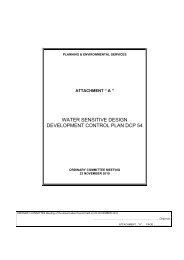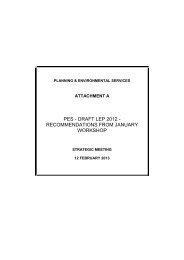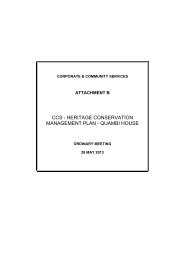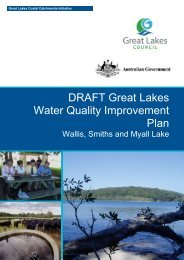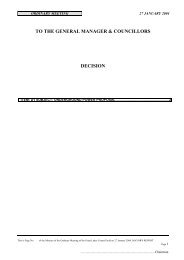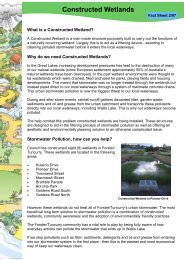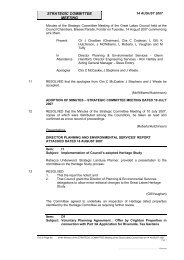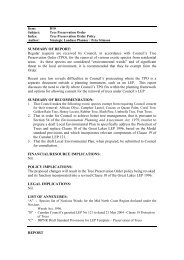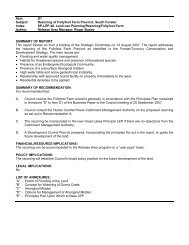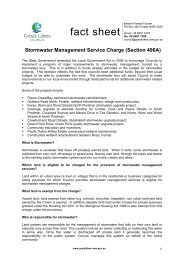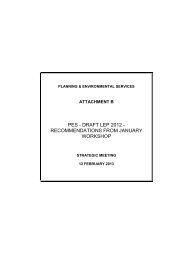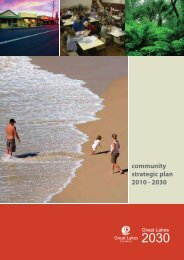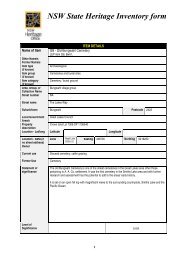13.2 The Wallis Lake Estuary Management Committee - Great Lakes ...
13.2 The Wallis Lake Estuary Management Committee - Great Lakes ...
13.2 The Wallis Lake Estuary Management Committee - Great Lakes ...
Create successful ePaper yourself
Turn your PDF publications into a flip-book with our unique Google optimized e-Paper software.
<strong>Wallis</strong> <strong>Lake</strong> <strong>Estuary</strong> <strong>Management</strong> Plan<br />
In addition to the above mentioned programs and projects a number of constructed works and services are also<br />
coordinated under the HLP, such as the provision of litter baskets and construction of artificial wetlands and gross<br />
pollutant traps.<br />
13.1.7 Darawakh drainage management plan<br />
<strong>The</strong> Darawakh drainage management plan was recently drafted in September 2003 to improve water quality<br />
discharges which are adversely affecting the estuary ecology, recreational amenity, oyster aquaculture and fishing<br />
industries. Past drainage works in the Darawakh wetland and Frogalla swamp have disturbed ASS, exporting acid<br />
products and resulting in severe water acidity in the mid to upper reaches of the Darawakh drainage system<br />
(Curlew Biological Services, 2000). This water, along with large quantities of iron mobilised by the acid, ultimately<br />
makes its way into the Wallamba River, which is significantly impacted especially during periods of heavy rain and<br />
hence high flow.<br />
This project was critical in providing landholders with an understanding of the water quality issues they currently<br />
face. Community engagement was an integral part of this plan in order to gain knowledge of local drainage patterns<br />
and drainage requirements and devise a range of remediation works and management strategies that will be<br />
embraced by landholders. Much of the outcomes of this plan rely on voluntary landholder adoption of the<br />
recommended management strategies, therefore emphasis was placed on developing ‘home-grown’, low cost and<br />
low impact solutions over highly engineered, costly measures.<br />
Some of the proposed management actions are to:<br />
• block the flow of acid groundwater leaving the study area via the constructed drains<br />
• reinstate the natural overland flows of surface water leaving the study area via the original channel and<br />
floodway of Darawakh Creek<br />
• reinstate tidal exchange and natural flood flows through the lower reaches of Darawakh Creek by<br />
removing the derelict floodgate headwall at the mouth<br />
• remove all cattle from the wetland<br />
• consolidate the wetland into a single landholding for environmental management purposes, and<br />
• establish a process whereby landholders can achieve increased development entitlements on the<br />
dryland parts of their holdings as an equitable offset for dedicating their wetlands to <strong>Great</strong> <strong>Lake</strong>s<br />
Council for acid drainage remediation purposes.<br />
However, in addition to the above actions it was acknowledged in the plan that the most cost-effective option in the<br />
long term may be land acquisition or some other means of transferring use rights.<br />
13.1.8 <strong>Estuary</strong> general fishery management strategy<br />
<strong>The</strong> estuary general fishery management strategy was prepared by NSW DPI in 2003 to comprehensively manage<br />
the State’s commercial estuarine general fishery. This fishery targets around 80 species using 17 different types of<br />
fishing gear in approximately 100 estuaries that are either permanently open or temporarily open and closed on the<br />
NSW coast. <strong>The</strong> long term goal of this strategy is:<br />
122




